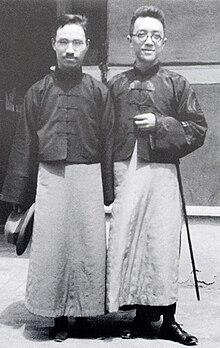Hu Xiansu

Hu Xiansu or Hu Hsien-Hsu (simplified Chinese: 胡先骕; traditional Chinese: 胡先驌; pinyin: Hú Xiānsù, 24 May 1894 – 16 July 1968), was a Chinese botanist and an influential traditional scholar of his time. He was a founder of plant taxonomy in China and a pioneer of modern botany research in the country.
Education and career[]
Hu Xiansu studied preparatory course at Imperial University of Peking in 1909. In 1912 after the 1911 Revolution he went to America, and graduated from University of California, Berkeley in 1916. In 1918, he became a faculty member of National Nanking Higher Normal School and then National Southeastern University (later renamed National Central University and Nanking University). He went to America again in 1923 and received a doctor's degree from Harvard University in 1925. His wife died in Nanking in 1926, then he resigned from Department of Biology of Southeastern University and became a full-time research fellow at Institute of Biology of China Science Society. He cofounded Fan Memorial Institute of Biology in Peiping (Beijing) in 1928. He founded in 1934 and Yunnan Institute of Agriculture and Forest (later renamed Kunming Institute of Botany, Chinese Academy of Sciences) in 1938.
Along with his colleagues of the Science Society of China, Hu was a key leader of the first biological research institute in the country, and played an important role in founding the . He established the first plantation for botanical research at Mount Lu in Jiangxi, and initiated or conducted large-scale survey of flora of China.
Between 1940 and 1944, he was the founding president of the National Chung Cheng University (renamed National Nanchang University 1949). In the 1940s, he played a key role, along with Wan Chun Cheng, in identifying and naming a new living species of Metasequoia previously known only from fossils, in Sichuan, China.[1]
In the 1950s, Hu was openly critical of Lysenko's anti-Mendelian doctrines in genetics and agricultural practices, despite heavy Soviet influences and political pressures at that time.
See also[]
Notes[]
- ^ Bell (2016), pp. 263, 269, 279.
- ^ IPNI. Hu.
References and further reading[]
- Bell, Andrew W. (2016). "A Tree Grows in China". Journal of American-East Asian Relations. 23 (3): 257–281. doi:10.1163/18765610-02303006.
External links[]
| Wikimedia Commons has media related to Hu Hsen Hsu. |
| Wikispecies has information related to Hsen Hsu Hu. |
- Chinese botanists
- Botanists active in China
- Presidents of universities and colleges in China
- Peking University alumni
- University of California, Berkeley alumni
- Harvard University alumni
- National Central University faculty
- Nanjing University faculty
- 1894 births
- 1968 deaths
- Members of Academia Sinica
- Educators from Jiangxi
- People from Nanchang
- Peking University faculty
- Republic of China science writers
- People's Republic of China science writers
- Writers from Jiangxi
- Biologists from Jiangxi